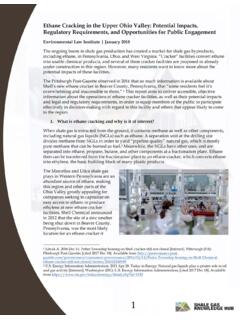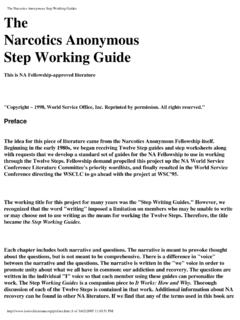Transcription of Step-by-Step Guide to Integrating Community Input into ...
1 Step-by-Step Guide to Integrating Community Input into Green Infrastructure ProjectsThis Guide was prepared by the Environmental Law Institute and Amigos Bravos. The primary authors are Teresa Chan, Rebecca Kihslinger, and John Hare-Grogg at ELI, and Michael Jensen and Rachel Conn at Amigos Bravos. Information included in this Guide comes largely from interviews with John Barney (County of Bernalillo), Amy Bell (Groundwork Studio), Jennifer Dann (New Mexico State Forestry), Sarah Hurteau (The Nature Conservancy), Juan Lopez (First Choice Community Healthcare), Joanne McEntire (J. McEntire LLC), Jennifer Owen-White (Valle de Oro National Wildlife Refuge, Fish and Wildlife Service), and Kieran Sikdar (Watershed Management Group).
2 The authors are grateful to these individu-als for their time and willingness to share their experience and for the Guide was provided by an EPA Urban Waters Small Grant. The contents of this Guide do not necessarily represent the views of EPA, and no official endorsement of the Guide or its contents should be inferred. Any errors or omissions are solely the responsibility of ELI and Amigos by Davonne Flanagan. Front and back cover photo by Aaron Volkening, 2014_10_10_WestCon-cApron_ LookS_a (from flickr), licensed under CC-BY Modified from Guide to Integrating Community Input into Green Infrastructure Projects. 2018 Environmental Law Institute , Washington, , and Amigos Bravos, Taos, rights Guide provides a Step-by-Step process that local governments can use to integrate Community Input into their green infrastructure projects.
3 It starts with a review of the benefits of involving the public in the decision-making process. It then sets out eight steps that local governments can take to involve the public. For each step , we provide details and tips to help local governments as they move through the process. These steps are directed at project development ( , local government has already committed to implementing a green infrastructure project in a particular Community and is looking for Input into project siting and design), but could be used for broader Community planning as well ( , developing a plan that will Guide future investments in green infrastructure in a particular Community ).INTENDED AUDIENCE: This Guide is primarily directed at local governments since many green infrastructure projects are carried out at the local-government level ( , they are initiated or required by local government).
4 The Guide could, however, be a useful resource for other groups looking to implement green infrastructure projects, like Community and non-profit organizations. Note that the information included in this Guide comes largely from interviews conducted as part of an Albuquerque-based project with representatives from local, state, and federal government, as well as from the non-profit and private sectors. A list of the interviewees is included in our Acknowledgments infrastructure: we use the term green infrastructure to refer to a way to collect and clean rainwater where it falls. Using plants and soil, green infrastructure projects reduce the amount of rainwater entering grey water infrastructure ( , storm sewers, pipes).
5 This can help reduce flooding. Green infrastructure projects can also help to clean and conserve water and provide recreational and other benefits to the : we use the word Community to refer to a group of people living in proximity to each other and who are the stated beneficiaries of and/or impacted by a project, in this case, a green infrastructure project that is intended to manage Involve the Community ?There are a number of challenges to involving the Community in the decision-making process. Chief among these is the additional resources ( , time, money) it often takes to effectively engage the Community . This can be particularly challenging for local governments that have limited For more information on green infrastructure, see our fact sheet What is Green Infrastructure?
6 What are the Bene-fits? (Feb 2017), available from 2So why involve the Community in the decision-making process? Aside from any potential legal requirements,2 there are a number of benefits to involving the Community , including: Improves Project Design: it is likely that Community members have useful information about their Community ( , where flooding occurs), which can help with the design and placement of the project. Community members can also provide guidance about how to design the project so that the Community will be more likely to use and be involved in the IN POINT:Local Water Councils Improve Cost Effectiveness of Danish Stream RestorationIn 2014, Denmark transitioned from a top-down water basin management planning approach, to a planning scheme informed by local water councils with Input from the public.
7 The incorporation of local knowledge about practical considerations of restoration proposals enabled a 135% increase in the amount of stream length proposed for restoration, compared with a plan designed by the national nature agency, using the same budgetary Helps Address Resource Constraints: Community participation can help address some of the resource constraints that local governments are facing. Community members can play a role throughout the process, from Community outreach to project planning, implementation, and maintenance. As one interviewee noted, a Community s assistance with project maintenance and monitoring allows local governments to focus their attention on other issues that require more expertise.
8 This means that local governments can stretch their limited resources further. Builds Support for Current Project: Community participation can help build support for the green infrastructure project. This could have important short-term benefits ( , Community supports the proposed project), as well as long-term ones ( , Community becomes long-term stewards of the project). Experimental evidence has shown that people who believed a decision was based on public Input rated that decision more favorably than those who were told the same decision was based only on expert opinion, suggesting that public participation itself improves For example, certain laws, like the National Environmental Policy Act (NEPA), may apply, which have public participation requirements.
9 3. Graversgaard M, Jacobsen BH, Kjeldsen C, Dalgaard T. Stakeholder engagement and knowledge co-creation in water planning: can public participation increase cost-effectiveness? Water. 2017; 9(191): 29 Arvai JL. Using risk communication to disclose the outcome of a participatory decision-making process: effects on the perceived acceptability of risk-policy decisions. Risk Analysis. 2003; 23(2):281-289; Dietz T and Stern PC [editors]. Public participation in environmental assessment and decision making. Washington (DC): National Research Council; 2008. 305 Builds Support for Future Projects: Community participation can also help build support for future green infrastructure projects.
10 By participating in the process, Community members have the opportunity to learn about and see the benefits of a green infrastructure project first-hand, which could translate into support for similar projects in the Ruiz, Green Roofs of the Civic Center (from flickr), licensed under CC BY Cropped from Could Lead to More Equitable Outcomes: Community participation along with certain other local government action may lead to more equitable outcomes (see the box below on More Equitable Outcomes for some actions that local governments can take).More Equitable OutcomesIn 2012, the non-profit organization PolicyLink released a paper on Community Campaigns for Infrastructure Equity: A Review of Four Case Studies.












